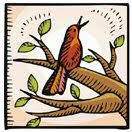State university extension services are a great resource.
Browsing around for some information about wild plums tonight, I came across a great page of questions and answers about plum trees (both wild and domestic plums). The website is titled "Hortiscope" and it's a ten-year archive of a newspaper column written by Dr. Ron Smith, a horticulturist for the North Dakota State University Extension Service.
All of the information is written with a North Dakota slant, of course, but I found plenty of things in the tree Q&A pages that were relevant to Kentucky. For example, in answer to a question about how to kill stumps, Dr. Smith wrote, "Spray any sprouts that come up with Roundup. Drill holes in the stump and fill them with saltpeter." I am going to try his suggestion about saltpeter on a pesky mimosa stump in our yard that refuses to die.

I don't know where to buy saltpeter, but I do know that if I don't find it at the local farm supplies, I can call my local county extension office and ask!
Try this Google search to find a wealth of extension service and other government publications about trees and forest.


 "The power to recognize trees at a glance without examining their leaves or flowers or fruit as they are seen, for example, from the car-window during a railroad journey, can only be acquired by studying them as they grow under all possible conditions over wide areas of territory. Such an attainment may not have much practical value, but once acquired it gives to the possessor a good deal of pleasure which is denied to less fortunate travelers."
"The power to recognize trees at a glance without examining their leaves or flowers or fruit as they are seen, for example, from the car-window during a railroad journey, can only be acquired by studying them as they grow under all possible conditions over wide areas of territory. Such an attainment may not have much practical value, but once acquired it gives to the possessor a good deal of pleasure which is denied to less fortunate travelers."
0 comments -- please add yours:
Post a Comment